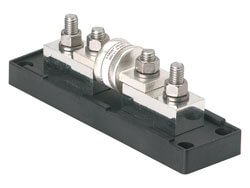Frank Enstine
New Member
- Joined
- Feb 25, 2022
- Messages
- 28
PDF attached
I think my design makes sense, but then I think it can’t be this straightforward and I must be missing some very important considerations. Your corrections/suggestions are greatly appreciated.
I live up north and can have 10-12 days a year in single digits (F). The application is off-grid, primarily back up power with a periodic secondary use case. My peak sun is 2-5 hours.
So, I’m considering an Epever 5420AN charge controller rated for 1250 watts (max 1875 watts), 200 Voc, 50 amps. Among panel options I’m considering are four 320 watt panels from Renogy rated for 32.7Vmp, 40.1Voc, 9.79A Imp. My PV wire run is <=100 feet.
Please help me see the errors of my way…
A 4S arrangement = 1,280 watts, 9.79A, 160.4Voc; 10 AWG @ 100’ = 1.3% drop. I’m not sure if I should be using the Voc or optimum Vmp (to calc the drop) which = 32.7 x 4 = 130.8V. That result would be 1.55% drop. The online calculator I used has a default power factor of .85, not sure if I should adjust that. Could I use 12AWG?
As far as charging current goes with the 4S array after the 1.3% drop, 1,263/28.2=44.8 charging amps. Is 28.2V the right charge voltage for a 24V LiFePo4 battery? Do I need to add a margin of safety and is that a problem for a 50 amp controller?
Am I correct that, in ideal conditions I could charge my 100Ah battery bank in just over two hours and at 72% of max charge current (32A) I could charge a nearly depleted battery bank in 3 hours.
Thoughts on the Epever controller and the Renogy panels? Alternatives?
Thank you all for supporting dummies like me.
I think my design makes sense, but then I think it can’t be this straightforward and I must be missing some very important considerations. Your corrections/suggestions are greatly appreciated.
I live up north and can have 10-12 days a year in single digits (F). The application is off-grid, primarily back up power with a periodic secondary use case. My peak sun is 2-5 hours.
So, I’m considering an Epever 5420AN charge controller rated for 1250 watts (max 1875 watts), 200 Voc, 50 amps. Among panel options I’m considering are four 320 watt panels from Renogy rated for 32.7Vmp, 40.1Voc, 9.79A Imp. My PV wire run is <=100 feet.
Please help me see the errors of my way…
A 4S arrangement = 1,280 watts, 9.79A, 160.4Voc; 10 AWG @ 100’ = 1.3% drop. I’m not sure if I should be using the Voc or optimum Vmp (to calc the drop) which = 32.7 x 4 = 130.8V. That result would be 1.55% drop. The online calculator I used has a default power factor of .85, not sure if I should adjust that. Could I use 12AWG?
As far as charging current goes with the 4S array after the 1.3% drop, 1,263/28.2=44.8 charging amps. Is 28.2V the right charge voltage for a 24V LiFePo4 battery? Do I need to add a margin of safety and is that a problem for a 50 amp controller?
Am I correct that, in ideal conditions I could charge my 100Ah battery bank in just over two hours and at 72% of max charge current (32A) I could charge a nearly depleted battery bank in 3 hours.
Thoughts on the Epever controller and the Renogy panels? Alternatives?
Thank you all for supporting dummies like me.



